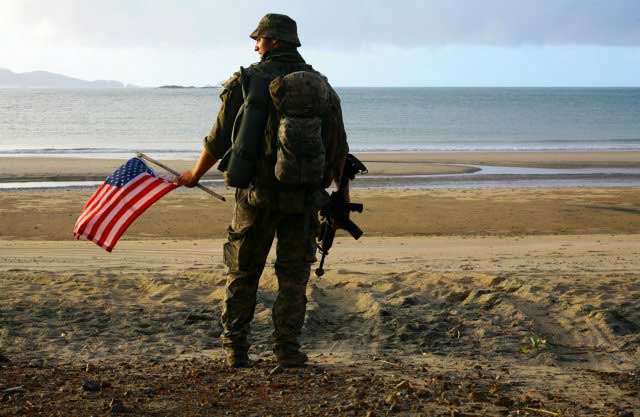The 1st Battalion, 69th Infantry Regiment New York – Guardians of Irish Heritage in The United States.
The name The 69th Infantry Regiment, or the “Fighting 69th” embodies the melding of Irish-American Culture, the precious preservation of heritage, the limitless abilities of immigrants and the preservation of a long and distinguished connection between Ireland and the United States.
The name The Fighting 69th was bestowed on the Regiment by Confederate General Robert E Lee and embodies epic and legendary actions of the most famed military Regiment to grace the pages of our history books.
Honoring the ideals of loyalty, honor and freedom.
The History of “The Fighting 69th”
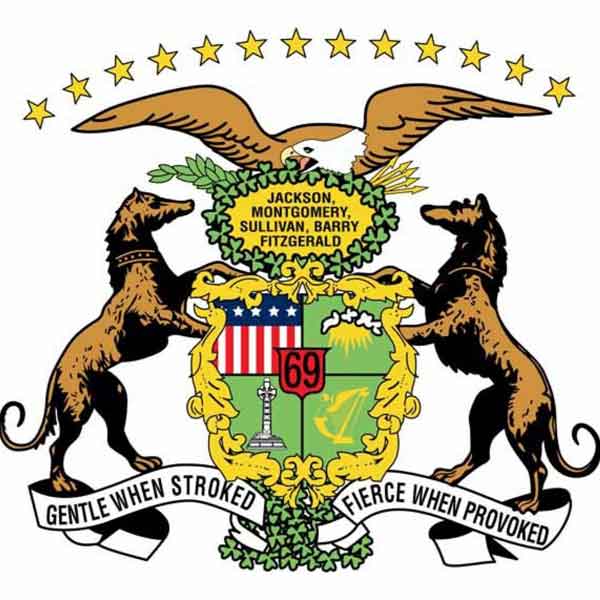
The history and world famous achievements of The Fighting 69th illuminates the pages of Irish American history.
The Fighting 69th was initially an Irish Heritage Unit, comprised of Irish immigrants, who had escaped from an Ireland of vicious hunger, disease, injustices and failed rebellions.
People who had lived under the Penal Laws which denied them their rights to freedom in their homeland. They set about a new life in The United States, a land of promise and freedom.
These brave men set about supporting the ideals of freedom, a sense of passion for a cause defending the rights of others, an experience they were familiar with defending those who could not defend themselves.
They lived with a deep conviction to the cause of freedom and their passionate duty to the United States to this day is unwavering.
The Fighting 69th embodies a greatness of spirit and faith in each other that has forever insured their rightful place as one of the most historic military Regiments in US, and modern world, history.
Their proud and legendary history preserved by all those who have sacrificed and continue to serve. Their proud history is interwoven with that of Ireland, The Fighting 69th embodies its Irish Heritage but also the heritage of all immigrants.
They have preserved some of the most wonderful Irish traditions, preserving the eternal bond that is forever enduring and unbreakable between Ireland and The United States.
The Fighting 69th are at the tip of the spear of preserving Irish Heritage in the United States, the majority of their traditions and emblems holding a deep rooted connection to Ireland.
Their regimental flag during the Civil War was green with the golden Irish harp, he flag of the Irish that was used until Thomas Francis Meagher flew the tricolor for the first time in 1848.
The Regimental flag bares a striking resemblance to that green flag of the Irish used during the failed 1798 Rebellion and again during the 1916 Rising.
The insignia of The Fighting 69th holds the keys to the Regiments past with its emblems holding deep and significant meaning. Containing the vivid red shamrock of the First Division, Second Corps of the army of the Potomac honoring its roots in the American Civil War.
The rainbow represents the unit’s service as a founding Regiment of the 42nd rainbow division during World War I. The 69th is the only infantry Regiment to have green as their background color instead of the traditional infantry blue, referring back to their Irish heritage (not true anymore).
The legendry and magnificent Irish wolfhound represented on the Regiment’s insignia is also the mascot of The Fighting 69th. The Irish Wolfhounds history and significance in Irish Heritage reflects perfectly the attributes of The Fighting 69th. The Irish wolfhound is a dog deeply associated with the traits of the loyalty, protective instincts and intelligence.
Wolfhounds were the dogs of war of ancient Irish and appear in the historic records from 320BC. Wolfhounds or Cu in Irish, were typically owned by warriors and nobility, gentle creatures but will protect their people with frightening ferocity. Wolfhounds were hunters but their most famed attribute was as guardians of people.
The wolfhounds despite their intimidating size are not an attack dogs and do not attach themselves to property but attach to people. Remaining steadfast and loyal, Guardians who protect their charge furiously. The motto of the Fighting 69th is “gentle when stroked and fierce when provoked”.
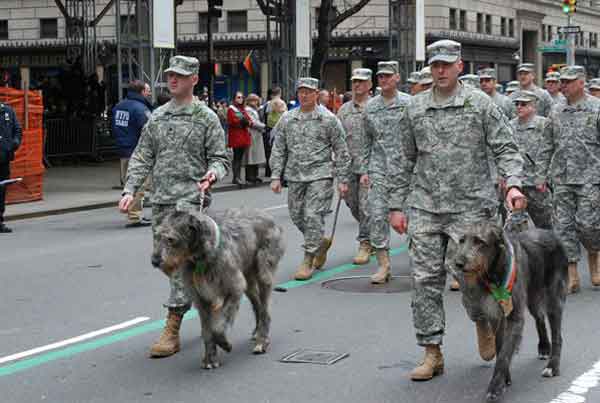
Holding on to the deep history of the New York National Guard the insignia of The Fighting 69th also contains the crest of Henry Hudson’s ship “The Half Moon”.
The Regiments Irish roots are also represented in their march, the well-known Irish march Garryowen. The regiment’s motto is also in Irish (Gaeilge) Faugh a Ballagh, which translates to “clear the way”
Never were men so brave. They ennobled their race by their gallantry on that desperate occasion. Thought totally routed, they reaped harvests of glory. Their brilliant though hopeless assaults on our lines excited the hearty applause of our officers and men.
Robert E Lee
In the years following the Great Famine (An Gorta Mor) there was mass exodus from Ireland to the United States. It is estimated that approximately 1 million died of starvation and disease in Ireland and 1 million left Ireland in search of a better life in The United States.
In the aftermath of the failed Young Irelander Rebellion of 1848 many Irish Revolutionaries moved to New York City. The Fighting 69th credits its founding in its present form to the Irish Revolutionary and Waterford native Thomas Francis Meagher.
New York City was a primary destination for many Irish Immigrants and tensions often ran high and in 1853 the 69th were called into restore order. There was a decision made that military units would not march in the Saint Patrick’s Day Parade due to the tensions within immigrant communities.
Several Irish Regiments were held to receive orders in the Parade Ground. Upon their release the 69th marched with fixed bayonets down Broadway, until they were dismissed. By the year 1858 the 69th were the only Irish Regiment in New York City.
In the year 1859 a new Irish Revolutionary Brotherhood was formed in the United States their leader was James Stephens who had been a revolutionary leader during the 1848 Rebellion in Ireland. The second in command was one of the most famous commanders of The Fighting 69th Michael Corcoran.
Michael Corcoran was appointed as the Colonel of the 69TH Regiment in 1860. Corcoran was also the leader of The Fenians, who were inspired by the principles that Ireland had a natural right to independence from foreign rule and that right could be obtained by the taking up of arms.
They took their name from the Fenian Cycle of Irish Mythology.
The Fianna were the legendary warriors of ancient Ireland that were lead by Fionn Mac Cumhall.
One of Michael Corcoran’s most famed acts was refusing to parade the Regiment during a visit by the Prince of Wales to New York City. A man of deep conviction he was protesting the injustices and human suffering that were inflicted by the British Ruling Classes in Ireland during the Great Famine.
He was arrested but was released without charge when the first shots were fired at Fort Sumter signaling the start of The American Civil War.
Famed for their bravery and ferocious fighting sprit and commitment to each other. The Fighting 69th were involved with most major engagements of the American Civil War. During The Battle of Bull Run, the 69th New York State Militia was sent to Washington in 1861.
They were heavily involved in engagement during the first Battle of Bull Run under the command of Colonel Michael Corcoran.
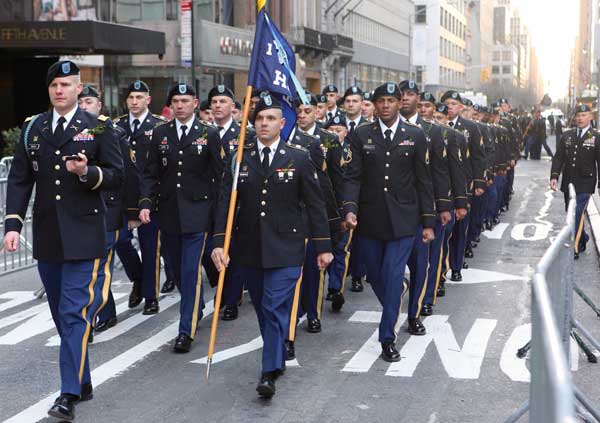
They were tasked with forming the rear guard to protect the retreating Union Army.
Upon completing 90 days service the 69th New York State Militia were re-enrolled as the 69th New York State Volunteers.
Meagher was responsible for the creation of the Irish Brigade; Meagher was promoted to Brigadier General and given command of the Irish Brigade.
Malven Hill saw the 69th lead a charge against the Louisiana Tigers (Confederate Irish Regiment). This historical event was when General Robert E Lee bestowed on the regiment its nickname The Fighting 69th. Antietam was the bloodiest battle of the Civil War.
General Meagher lead The Fighting 69th in the battle charging the Sunken Road also known as Bloody lane, The Regiment suffered a causality rate of 60% this was the bloodiest day in the history of the United States. Their bravery and their fearless reputation became epic in the annals of military history.
The Fighting 69th was almost decimated during its engagement with Confederate forces during the Battle of Fredericksburg, suffering more casualties then at Antietam. So brave and fearless was their determination and fearlessness that Confederate Forces, cheered the Fighting 69th.
“Your soldier’s heart almost stood still as he watched these sons of Erin fearlessly rush to their death. The brilliant assault on Marye’s Heights of their Irish brigade was beyond description. Why, my darling, we forgot they were fighting us, and cheer after cheer at their fearlessness went up all along our lines.”
General George Pickett
The day after the Battle of Fredericksburg the Regiment was presented with its second colors a set of which now hangs in Leinster House in Dublin, home to Dail Eireann, the Irish Parliament. These were presented to the Oireachtas in 1963 by John F Kennedy.
After the Battle of Chancellorsville only 300 men remained in the Regiment. General Meagher resigned and Patrick Kelly was named the new commander of the Irish Brigade.
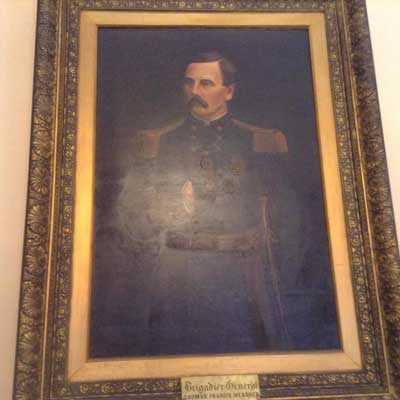
During the Battle of Gettysburg although outnumbered the Regiment held the Wheatfield until they were eventually overwhelmed. The Irish Brigade served until the end of the Civil War and were, present when General Robert E Lee surrendered at Appomatiox.
The Regiment marched in the victory parade in Washington DC. Upon their return to New York City all the Regiments of the Irish Brigade were disbanded with the exception of The Fighting 69th.
The Fighting 69th hold onto many traditions that go back to the American Civil War. These traditions are upheld and regarded in the highest esteem. Their heritage linked to those of many Irish military traditions.
The regimental cocktail is said to have been a favorite of Thomas Francis Meagher, it is Irish whiskey mixed with champagne. During the Battle of Fredericksburg Michael Corcoran presented every man with a sprig of boxwood which the soldiers wore as a representation of their Irish heritage.
The Fighting 69th celebrate their anniversary on the 17th of March, Saint Patrick’s Day. The Regiment led out the New York City Saint Patrick’s Day parade as they have done for 167 years, Regimental officers and senior NCO’S carry Shillelaghs as a reference to their rank.
There are countless monuments and memorials dedicated to the Fighting 69th throughout the United States including Antietam, Fredericksburg, Gettysburg and many other Civil War battlegrounds.
No greater fighting regiment has ever existed than the One Hundred and Sixty-fifth Infantry of the Rainbow Division, formed from the old Sixty-ninth Regiment of New York. I cannot tell you how real and how sincere a pleasure I feel tonight in once more addressing the members of that famous unit. You need no eulogy from me or from any other man. You have written your own history and written it in red on your enemies’ breast but when I think of your patience under adversity, your courage under fire, and your modesty in victory, I am filled with an emotion of admiration I cannot express. You have carved your own statue upon the hearts of you people, you have built your own monument in the memory of your compatriots.
General Douglas MacArthur
During the First World War, The Fighting 69th was re designated to 165th Infantry Regiment.
The Regiment was sent to the Western Front in 1917 attached to the 42nd Rainbow Division of the American Expeditionary Force under the command of General John J Pershing.
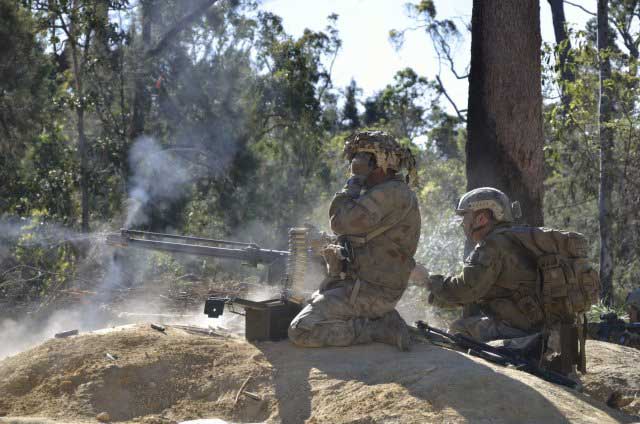
Since World War I all members of the 69th have been designated honorary Irishmen, thanks to Father Duffy who described all soldiers of the Regiment as “Irish by adoption, Irish by association or Irish by conviction”.
The Regiment saw some of the worst fighting of the war. Bearing witness to the horrors of the ice-cold bitterness of European winter.
They were present at Rouge Bouquet, an event immortalized in the poem “Rouge Bouquet” by Sergeant Joyce Kilmer, who was a world-famous poet prior to enlisting in the 69th.
They were present at Champagne where they suffered causalities as a result of a mustard gas attack. At Chateau Thierry the Fighting 69th led the crossing of the Quran River and suffered heavy losses, including Sergeant Joyce Kilmer.
As a result of heavy casualties other regiments in the area declared that they were unable to advance on the line of retreating German forces. The Fighting 69th although crippled by losses declared that they “consider an order to advance as a compliment”.
Brigadier General Douglas MacArthur declared of the Fighting 69th “ By god it takes the Irish when you want a hard thing done.” At St, Michael, The Fighting 69th, as part of the Rainbow Division would form part of the flanking right at the North East of Beaumont, where the 1st Tank Brigade of LTC George Patton was positioned.
The Regiment suffered losses but took thousands of German prisoners. The Rainbow Division along with the Fighting 69th relieved the 1st Infantry Division at Meuse- Argonne, where the Regiment again suffered heavy causalities on the 7th of November 1918. The War to end all Wars ended 4 days later. The Fighting 69th returned home to New York City in early 1919.
The distinguished service of The Fighting 69th has immortalized the Regiment in the annals of military history. 3 soldiers of the fighting 69th were awarded the highest military honor; the Medal of Honor and 60 members were awarded the Distinguished Service Cross.
This war also saw the amazing soldiers of the 69th remembered forever in the most reverend terms. Father Francis Duffy also referred to as the “The Fighting Chaplain” and the father of the modern US Army Chaplain Corps, seen in the deepest bloodiest parts of the battle, giving assistance to wounded, administering the last rites to the dying, burying the dead, constantly being a guiding forced and a source of encouragement to the men, all while unarmed and he never gave a thought to his own life or safety.
His only thought was of the men of The Fighting 69th.
Brigadier General Douglas MacArthur considered making Father Duffy the commander of the regiment; it was unheard of that a chaplain would even be considered for this role. Father Duffy was an inspirational figure to the Soldiers of the fighting 69th and even in death still inspires the Soldiers of this historic unit.
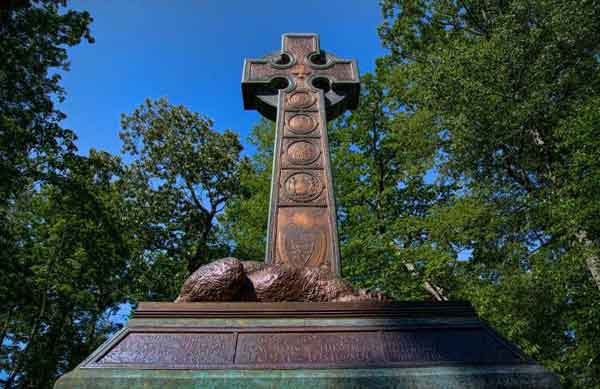
There is a statue forever remembering the remarkable Father Duffy situated on the North End of Time Square or its official name Duffy Square. The heroic Soldiers who lost their lives during World War 1, including Poet Joyce Kilmer are interred at Oise – Aisne American Cemetery and memorial in France.
The Fighting 69th answered the call again during the Second World War, serving with distinction and honor. During World War II The Fighting 69th still retained the designation the 165th infantry, serving with the 27th Division, the New York Sate National Guard Division.
The Fighting 69th took part in some of the most vicious fighting to occur in the Pacific Theatre of WWII. Engaging with Japanese forces on Makin Island.
The 165th became the regimental combat team after being supplemented with heavy artillery and armor. The Battle of Makin Island commenced on 20th of November 1943. Despite heavy fire and Japanese opposition on Makin Island was subdued on the 23rd of November 1943.
During Saipan, the 27th Division served as an amphibious reserve in the support of The Marine Corps in the initial phases of the Battle of Saipan. The Marine divisions suffered devastating casualties. The Fighting 69th were the first army unit to set foot on Saipan. Under constant fire and opposition from a heavily armed and determined forces, of the Japanese, 2nd Battalion successfully took the main objective the Aslito Airfield.
The Regiment was then redeployed to clear the infamous “Purple Heart Ridge” and accomplished the mission under impossible odds. The Regiment was ordered to quell isolated pockets of enemy resistance thought-out Saipan, eventually leaving on 25th of March 1945. They were then sent to one of the bloodiest islands of the war Okinawa. Initially serving as a reserve to the 1st and 6th Marine Divisions along with the United States Army 7th and 96th Divisions.
Forces moved rapidly through the island until they reached The Machinate Line, causalities were devastating and the 27th division were sent to reinforce the right flank. Okinawa was treacherous and fraught with violent resistance by a dedicated and severely dug in enemy who were in defensive positions on the ridges and tunnels of Okinawa.
They took the Machinate Airfield on 26th of April against overwhelmingly odds and were cut off. Their gallant efforts were awarded with the Distinguish Unit Citation. The Fighting 69th left Okinawa on the 9th of September 1945.
On September 11 2001, The Fighting 69th responded to the terrorist attacks on the World Trade Centre in New York City. Soldiers reported to The Armory, Lexington Avenue and 25th Street in midtown Manhattan to help the people of New York City. The Fighting 69th was one of the first military units to arrive at and help secure Ground Zero.
The 69th helped other first responders in rescue efforts and later search and recovery efforts. On that tragic day The Fighting 69th lost two of their own, 1st Lieutenant Gerard Baptiste a member of the FDNY and Specialist Thomas Jurgens of NYS Courts. In the aftermath of 9/11, 200 soldiers from the 69th were mobilized to protect West Point the United States Military Academy. Soldiers of The 69th were also tasked with protecting power plants, airports and other transport facilities. This protection detail was known as Operation Nobel Eagle.
Operation Iraqi Freedom would see the 69th federalized for combat duty. Under the command of Lieutenant Colonel Geoffery Slack and Command Sergeant Major George Brett, The Fighting 69th would deploy for an overseas combat mission.
Their first since World War II. The Regiment performed combat roles in Taji, Radwinlyah and Baghdad. In Baghdad The 69th was responsible for protecting the “Route Irish” an infamous airport route connecting The Green zone to Camp Victory.
During Operation Enduring Freedom in Afghanistan, 300 soldiers of the Fighting 69th deployed as part of Task Force Phoenix attached to the 27th Infantry Brigade Combat Team in 2006. The Fighting 69th stands ready to answer a call to active duty. This historic unit maintains constant training and maintains its profound professionalism.
“One of the most outstanding characteristics of the regiment was its deep sense of religious responsibility, inculcated by one of my most beloved friends – Father Duffy. He gave you a code that embraces the highest moral laws, that will stand the test of any ethics of philosophers ever promulgated for the uplift of man. Its requirements are for the things that are right and its restraints are from the things that are wrong. The soldier, above all men, is required to perform they highest act of religious teaching – sacrifice.” General Douglas MacArthur
Irelands national memorial to the fighting 69th is in Ballymote, County Sligo the birthplace of famed Civil War Brigadier General Michael Corcoran. The bronze monument depicts scenes from Corcoran’s life. At the base of the monument is a chamber set into the ground containing a piece of steel from the World Trade Centre which was donated by the parents of Firefighter Michael Lynch who died during the attacks during 9/11. Corcoran is buried in Calvary Cemetery Woodside, Queens, New York.
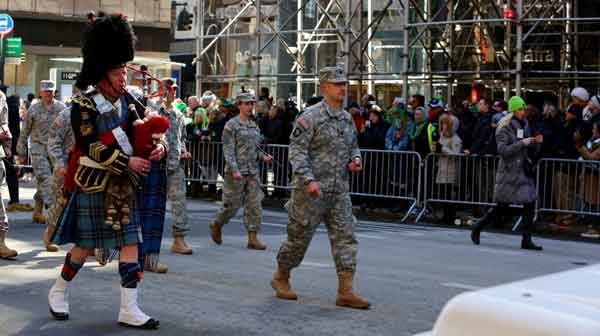
The 69th Regiment Armory on Lexington Avenue at 25th Street in New York City is home to the Fighting 69th.
The Armory’s lobby is a museum dedicated to the Regiments historic past and contains artifacts of wondrous historic significance.
The 69TH Regimental Armory was declared an official historic landmark in New York City in 1983 and continues to be a part of this historic regiments glorious past even featuring on a US postage stamp.
The close relationship between The Fighting 69th and Ireland is also honored every year when Soldiers from the regiment travel to Waterford City to take part in Ireland Tricolor Celebration maintaining a constant and enduring friendship with Ireland and their heritage.
The Fighting 69th upholds a wonderful bond with Ireland sending Soldiers to Waterford City in Ireland to celebrate The Tricolor Celebration. This wonderful event takes place in Waterford City each year. This celebration honors Thomas Francis Meagher the Civil War Brigadier General who is credited with founding the Fighting 69th and the man who first flew our precious national flag, the Tricolor from No. 33, The Mall, in the heart of what is now known as the Viking Triangle. We hope the Soldiers of the Fighting 69th enjoy their trips to our beautiful hometown and Ireland’s oldest City.
Do na daoíae go leir thúg seirbhís agus a thúgann seirbhís, táiníd Aór-bhuioch díbh as bhúr ndualgus agus as bhúr íobairt, go sibh slan, go maire sibh agus an grásta Dé a bheith in éineacht leat.
“Go Mairidís Beo” – “That Others May Live”
To all those who have served and continue we thank you for your duty and sacrifice. May you go safely and with the grace of God.

